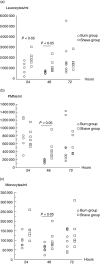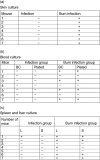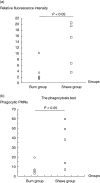Thermal injury induces impaired function in polymorphonuclear neutrophil granulocytes and reduced control of burn wound infection
- PMID: 19210518
- PMCID: PMC2673747
- DOI: 10.1111/j.1365-2249.2008.03861.x
Thermal injury induces impaired function in polymorphonuclear neutrophil granulocytes and reduced control of burn wound infection
Abstract
Severe thermal injury induces immunosuppression, involving all parts of the immune system, especially when large fractions of the total body surface area are affected. An animal model was established to characterize the burn-induced immunosuppression. In our novel mouse model a 6% third-degree burn injury was induced in mice with a hot-air blower. The third-degree burn was confirmed histologically. The mice were allocated into five groups: control, shave, burn, infection and burn infection group. At 48 h, a decline in the concentration of peripheral blood leucocytes was observed in the group of mice with burn wound. The reduction was ascribed to the decline in concentration of polymorphonuclear neutrophil leucocytes and monocytes. When infecting the skin with Pseudomonas aeruginosa, a dissemination of bacteria was observed only in the burn wound group. Histological characterization of the skin showed a more polymorphonuclear neutrophil granulocytes (PMNs)-dominated inflammation in the group of mice with infected burn wound compared with the with burn wound group. In contrast, a higher degree of inflammation was observed in the burn wound group compared with the group of mice with infected burn wound. Furthermore, the oxidative burst and the phagocytic capacity of the PMNs were reduced in the group of mice with burn wound. Using this novel mouse model of thermal injury a decline of peripheral leucocytes was observed, whereas the increased local inflammatory response at the site of infection showed reduced capacity to contain and eliminate the infection.
Figures




References
-
- Mayhall CG. The epidemiology of burn wound infections: then and now. Clin Infect Dis. 2003;37:543–50. - PubMed
-
- Tang K, Jian L, Qin Z, Zhenjiang L, Gomez M, Beveridge M. Characteristics of burn patients at a major burn center in Shanghai. Burns. 2006;32:1037–43. - PubMed
-
- O'Sullivan ST, O'Connor TPF. Immunosuppression following thermal injury: the pathogenesis of immunodysfunction. Br J Plast Surg. 1997;50:615–23. - PubMed
-
- Edwards-Jones V, Greenwood JE. What's new in burn microbiology? Burns. 2003;29:15–24. - PubMed
-
- Tredget EE, Shankowsky HA, Rennie R, Burrel RE, Logsetty S. Pseudomonas aeruginosa in the thermally injured patient. Burns. 2004;30:3–26. - PubMed
Publication types
MeSH terms
LinkOut - more resources
Full Text Sources
Medical

